


The Emperor Franz Joseph Railway (German: Kaiser-Franz-Josephs-Bahn, KFJB) was an Austrian private railway company, named after Emperor Franz Joseph I. It operated railway lines from the Austrian capital Vienna to Prague and Eger (Cheb) in Bohemia.



The Emperor Franz Joseph Railway (German: Kaiser-Franz-Josephs-Bahn, KFJB) was an Austrian private railway company, named after Emperor Franz Joseph I. It operated railway lines from the Austrian capital Vienna to Prague and Eger (Cheb) in Bohemia.
The stock company ( Aktiengesellschaft ) was founded by the Bohemian noble Prince Johann Adolf II of Schwarzenberg (1799–1888), a brother of former State Chancellor Prince Felix of Schwarzenberg, who had a first 455 km (283 mi) long railway line built from Vienna to Eger, starting after the Austro-Prussian War of 1866. The groundbreaking ceremony was held on November 18 near Schwarzenberg's Frauenberg Castle in Bohemia. The first section between Budweis (Budějovice) and the Pilsen (Plzeň) coal basin was inaugurated on 1 September 1868. It was extended to Eggenburg in Lower Austria on 1 November 1869 and train service to Vienna began on 23 June 1870. The railway line from Vienna via Gmünd to Prague was completed by 14 December 1871. When the northwestern branch was extended from Pilsen to Eger on 28 January 1872, the KJFB network comprised 715 km (444 mi).
In 1872, Vienna Franz Josef Station was opened as the first terminal station inside the former Linienwall in the district of Alsergrund, inside the Gürtel. It crossed the Danube at Tulln and extended from there to Krems and to the border with Bohemia at Gmünd. In Bohemia, it continued through Budweis, Tábor and Benešov to Prague. Prague's present main station originally belonged to the Franz Josef Railway company. Various district capitals are only connected to it by bylines.
The KFJB was nationalized by the Imperial Royal Austrian State Railways on 1 May 1884. After World War I, a new station at Gmünd had to be built in 1919, after part of the town had become part of Czechoslovakia ( České Velenice ). After World War II, the line lost a lot of importance because of the Iron Curtain. However, trains to Prague and Berlin used it through the mid-90s. Today, the Franz Josef Railway is only used for regional trains, as trains to Prague run via Wien Meidling and Brno, and along the first Czech railway corridor. However there is still a train going to the city of Budweis via Gmünd to this date.
Sections built by the Emperor Franz Joseph Railway company: [1]

České Budějovice is a city in the South Bohemian Region of the Czech Republic. It has about 96,000 inhabitants. The city is located in the valley of the Vltava River, at its confluence with the Malše.
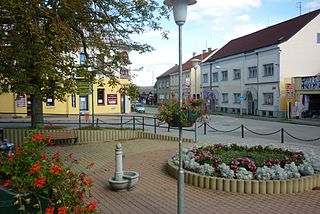
České Velenice is a town in Jindřichův Hradec District in the South Bohemian Region of the Czech Republic. It has about 3,600 inhabitants. It lies on the border with Austria and is adjacent to the town of Gmünd, to which it once belonged.

Veselí nad Lužnicí is a town in Tábor District in the South Bohemian Region of the Czech Republic. It has about 6,500 inhabitants. It lies at the confluence of the Lužnice and Nežárka rivers.
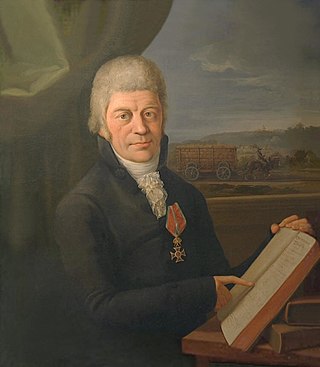
Franz Josef Gerstner was a German-Bohemian physicist, astronomer and engineer.
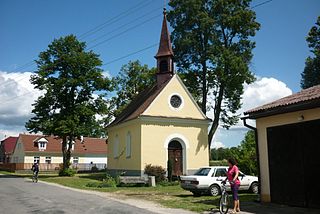
Suchdol nad Lužnicí is a town in Jindřichův Hradec District in the South Bohemian Region of the Czech Republic. It has about 3,600 inhabitants.
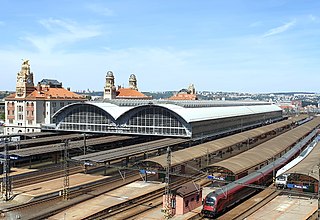
Praha hlavní nádraží is the largest railway station in Prague, Czech Republic.
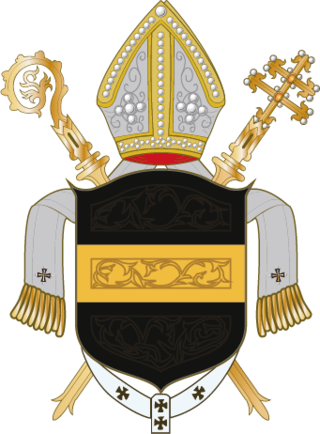
The Archdiocese of Prague (Praha) (Latin: Archidioecesis Pragensis; Czech: Arcidiecéze pražská) is a Metropolitan Latin archdiocese of the Catholic Church in Bohemia, in the Czech Republic.
These are all the Czech rail border crossings as of 2007. Crossings in italics are abandoned. The year of opening is in brackets.

Wien Franz-Josefs-Bahnhof is a train station in the Alsergrund district of Vienna, Austria. It serves as the southern terminus of the Franz-Josefs-Bahn.

Gmünd is a town in the northwestern Waldviertel region of Lower Austria and the capital of the Gmünd district. The municipality consists of the Katastralgemeinden Böhmzeil, Breitensee, Eibenstein, Gmünd and Grillenstein. Situated on the Lainsitz (Lužnice) river where it forms the border with České Velenice in the Czech Republic, it is an important road and railway crossing point, next to the Blockheide protected area.

Lomnice nad Lužnicí is a town in Jindřichův Hradec District in the South Bohemian Region of the Czech Republic. It has about 1,800 inhabitants.

Praha-Vršovice railway station is a railway station located in Prague 4, located at the edge of Vršovice and Nusle, which carried 1,826,000 passengers in 2009. The station is located on the main line from Praha hlavní nádraží to České Budějovice, and the local line to Dobříš and Čerčany via Vrané nad Vltavou.

The Vindobona is an international named passenger train which began service in 1957 between Berlin and Vienna via Dresden and Prague. In later years the route was extended to run from Hamburg via Berlin, Dresden, Prague, Brno and Vienna to Villach. It was named after the ancient settlement of Vindobona on the site of the modern city of Vienna. Labelled as a EuroCity train connection from 1993, services discontinued in 2014.
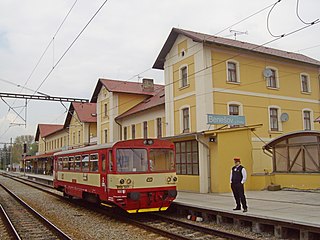
Benešov u Prahy is a railway station in Benešov in the Czech Republic. it is located on the Benešov–České Budějovice railway, Prague–Benešov railway and Benešov–Trhový Štěpánov railway. The train services are operated by České dráhy.

Plzeň main railway station is the principal railway station in Plzeň, the largest city in western Bohemia. The station is located in the Slovany district near the city center. The station was opened in 1862, together with the Czech Western Railway from Prague to Plzeň. The station has six platforms for train transport and one platform for buses. There are also tram and trolleybus stops. The station is electrified.

České Budějovice railway station is a mainline railway station and marshalling yard in České Budějovice in the Czech Republic. It is located at the junction of an international corridor leading from Prague south to Linz in Austria with several domestic lines. The Neo-Renaissance station building, completed in 1908, is located on Nádražní street, a short walk east of the old town. Most passenger services are operated by Czech Railways but some are operated by Arriva.

Cheb railway station is a railway station in the city of Cheb in the Karlovy Vary Region in the western part of the Czech Republic.
The Franz-Josefs-Bahn is a standard gauge railway line in the Austrian state of Lower Austria. It runs 163.1 kilometres (101.3 mi) from Vienna, the Austrian capital, to the border with the Czech Republic at Gmünd. The line was originally built by the Emperor Franz Joseph Railway and is today owned and operated by Austrian Federal Railways (ÖBB).

The Budweis-Linz-Gmunden Horse-Drawn Railway was the second public railway line to be opened in mainland Europe. It opened in stages between 1827 and 1836, and principally served the transport of salt from the Upper Austrian Salzkammergut to Bohemia.